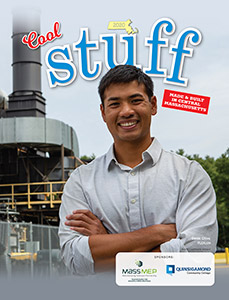Manufacturing offers new opportunities, regardless of gender
When Karen Trunzo started work in 1998 at Biddeford-based Sterling Rope Co., she had no plans to be a trailblazer for women in Maine’s manufacturing industries. Instead, she was looking for a steady paycheck.
“Jobs were hard to come by,” she says, especially in the local textile industry. Trunzo, then 28, had worked at a Biddeford Textile Co. plant for several years, but had been temporarily laid off several times. She was worried about job security. She saw an ad for an opening at a rope manufacturing company and she applied immediately.
Trunzo became one of five full-time employees on Sterling’s production floor, and one of two women there.
“It was a challenge from the start,” Trunzo says.
Although she found some similarities between braiding rope and weaving blankets at Biddeford Textile, the learning curve was steep. “Patterns were different, machinery was different, a lot of things were different.”
But Trunzo persisted. Sterling Rope had just moved to Maine from Massachusetts. As the company grew, Trunzo eagerly took on new duties, from braiding to winding rope coils to shipping product. She learned new skills along the way
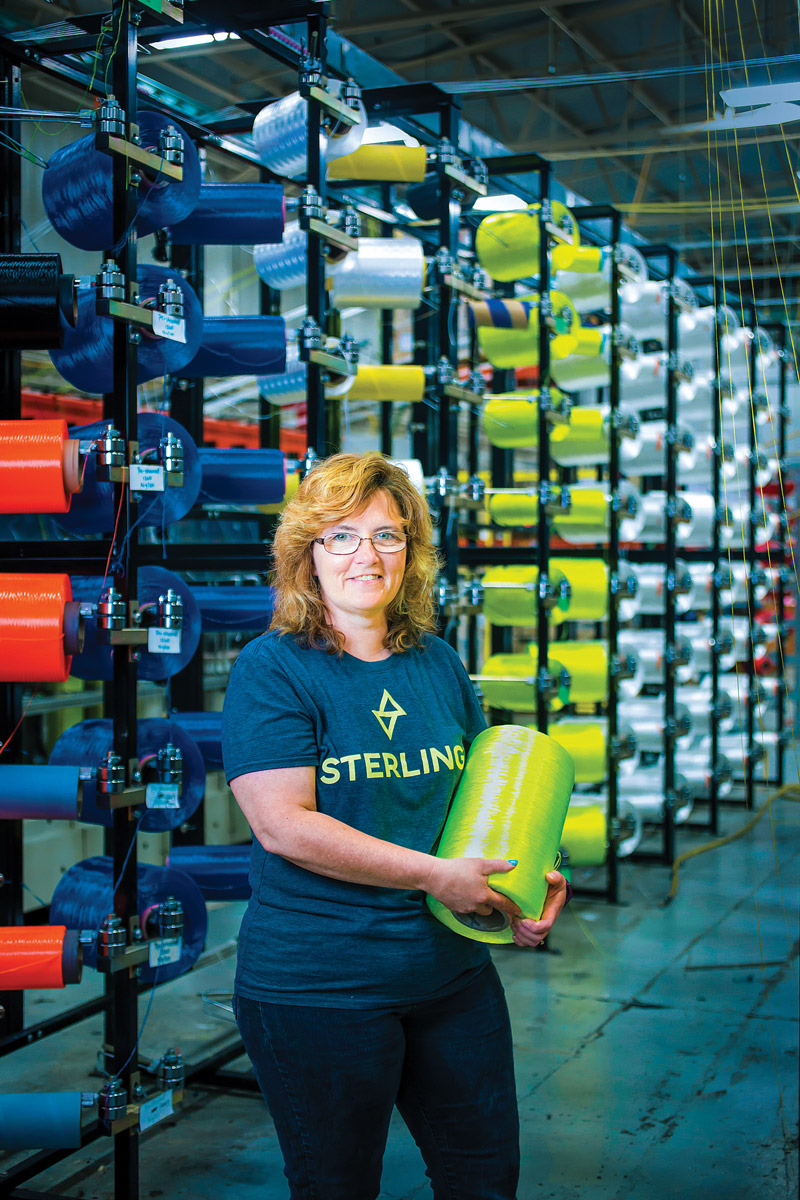
Karen Trunzo, production manager at Sterling Rope Co., joined the company in 1998. She has held a variety of jobs over 20 years.
“Eventually, I worked at every job on the floor, from one end to the other. I liked the challenge. If you give me a chance to learn a new job, I’m going to learn it.”
— Karen Trunzo
Production manager, Sterling Rope Co.
“Eventually, I worked at every job on the floor, from one end to the other,” she says. “I liked the challenge. If you give me a chance to learn a new job, I’m going to learn it.”
Now, 20 years later, Trunzo is the production manager at Sterling Rope, overseeing 40 manufacturing workers for one of the world’s leading makers of rope used by mountain climbers, tree trimmers and fire-rescue crews.
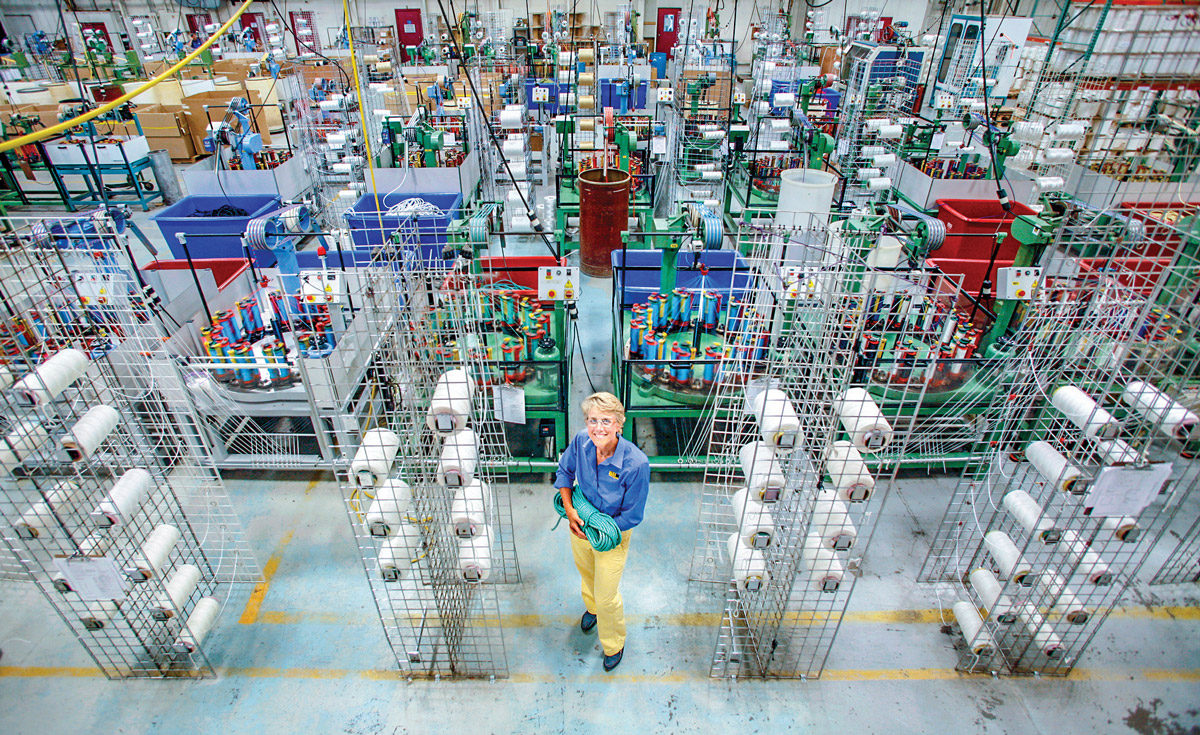
Carolyn Brodsky, president and co-founder of Sterling Rope Co., has created opportunities for women in manufacturing.
Women in manufacturing jobs
Trunzo’s professional success may seem unusual in light of recent statistics. While women made up 47% of the U.S. labor force in 2016, according to U.S. Census data, they comprised only 29% of manufacturing employees. In Maine, only 5% of female workers are employed in manufacturing, a 2013 national survey found, ranking No. 44 nationally and at the bottom in New England.
The numbers are different at Sterling Rope, where President and co-founder Carolyn Brodsky says about half of her employees are female — the result of a “conscious decision” to hire an equal balance of men and women.
Brodsky says the female staff bring a “diversity of thought” to the company’s work.
“It’s critical. Women think differently, we solve problems differently than most guys do,” Brodsky says.
Brodsky’s confidence in the women she employs is contagious.
“[Brodsky] pushed me to open my horizons,” Trunzo says. “When I didn’t have the confidence to do something new, she challenged me to try it.”
A different strength
A willingness to try has also led to success for Kathie Leonard, president and CEO of Auburn Manufacturing Inc., which makes heat-resistant fabrics for welding, insulation and other industrial applications.
Leonard and a business partner launched the company in 1979, when she was 27. Her only prior industry experience had been a few years as an executive secretary with W.S. Libbey, which used to be a textile manufacturer in Lewiston. Leonard had studied technical writing in college, and had “a natural curiosity about how products work and meet customer needs,” she says. “And I love customer service.”
In its first year, Auburn Manufacturing had revenue of $50,000. The next year, sales grew to $300,000. The private company doesn’t disclose financial figures today, but its yearly output exceeds 2 million yards of fabric, supplying hundreds of product lines for customers in more than 30 countries.
Leonard, who was a 2018 Mainebiz Business Leader of the Year in the small-business category, credits at least some of Auburn Manufacturing’s success to nontraditional skills.
“I think I brought a softer side to manufacturing,” she says. “I can’t run our equipment, but I’m good at listening to customers, understanding them and communicating what they want.”
“A lot of women can do that, even if we sometimes think we can’t,” she adds. “As sexist as it may sound, we’re service providers by nature.”
With facilities in Auburn and Mechanic Falls, Auburn Manufacturing employs nearly 50 workers and is a certified Women’s Business Enterprise.
Jennifer Merrill, a purchasing specialist at Auburn Manufacturing, joined the company two years ago.
Previously, she had served as a bookkeeper for a tire retreading business. She says her new job required her to quickly learn new skills and adapt to a new industry. But she also enjoyed a new work environment that she attributes partly to a “patient boss” and the company’s female leadership.
“It’s different here,” Merrill says. “There’s a reasonableness, an emphasis on thinking through the work process and keeping people happy. You’re expected to be respectful, and you’re respected.”
But with women leading successful manufacturers and encouraging women to join the field, why are so few women going to work in Maine factories?
Perception might be part of the problem.
Vision difficulties
First, the gender bias that affects women in other occupations seems to run strong in some manufacturing fields. Leonard recalls meeting businessmen who refused to believe she owned and operated a textile company.
“They’d ask, ‘Are you a chemist?’ or ‘Is this your father’s business?’” she says. “You have to develop a thick skin and a sense of humor.”
At American Roots, a Westbrook manufacturer of apparel and blankets, co-founder and President Whitney Reynolds says being female in a largely male industry like textiles “always presents a challenge.”
“It’s disappointing, but it is an issue, even today when people are extremely aware of it,” says Reynolds.
Last year, she and her husband and American Roots co-founder, Ben Waxman, were honored as a Mainebiz Next award winners in recognition of their impact on the state’s business community.
“As a woman business owner, I’ve found difficulties,” she says. “For example, in a meeting people will often gravitate to my partner simply because he’s male.”
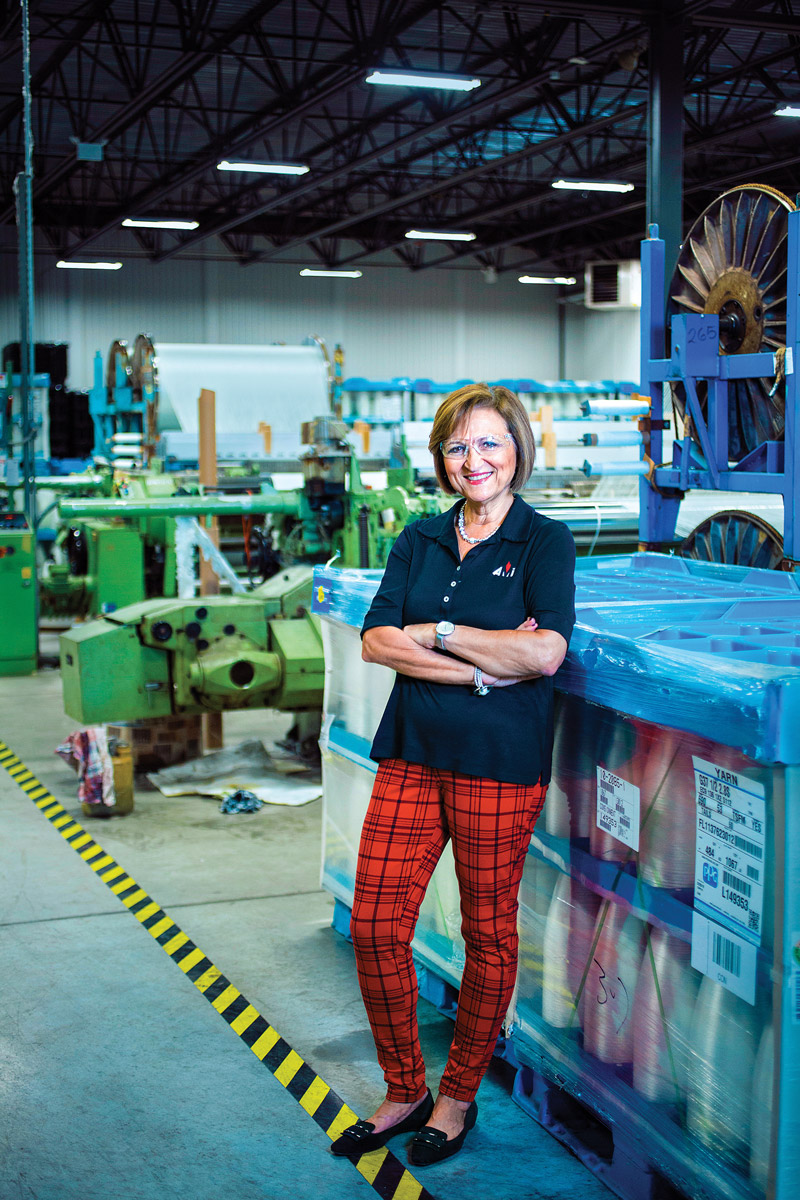
Kathie Leonard, president and CEO of Auburn Manufacturing Inc., started the company when she was 27 years old.
While others may have misconceptions about women in manufacturing, women may have misconceptions about manufacturing itself.
“The manufacturing jobs of the past were often dirty, greasy jobs, the last type of job you’d want,” says Brodsky of Sterling Rope. “There’s still a negative connotation about manufacturing. People try to avoid the word.”
The outdated image remains prevalent. A 2017 survey by the Maine Manufacturers Association found that public perception of the field was the No. 2 hiring challenge for the group’s members, seen as a problem by 23% of those responding. It ranked second behind an even more pressing, everyday problem: Finding qualified workers. Access to talent was the top challenge, according to 58% of the respondents.
“Women often fear asking for help, often don’t want to speak up. But my suggestion [for those entering manufacturing] is just do it. Even if you don’t know how, do it. Put your hand up, and ask for help if you need it, especially if you can find a mentor … Ultimately, what I need is people who know how to ask questions.”
— Carolyn Brodsky
President, Sterling Rope Co.
The heavy physical work once common on factory floors can be discouraging to female job applicants. But Brodsky and her production manager, Trunzo, say those demands don’t have to be an obstacle for women workers.
“We’re constantly innovating,” Trunzo says. “We listen to suggestions and try to adapt the job to the employee, female or male, so that it puts less stress on the body.”
At Auburn Manufacturing, Leonard says, “It’s not necessary to be able to do everything, or to know everything. But as women, we sometimes sell ourselves short.”
The female workers at American Roots “are some of the strongest women I know,” says Reynolds. Of the workforce of 20 people, 16 are women. Most are also new Mainers. She notes that many of these employees have already braved daunting personal challenges before they first walk into the mill.
“Even being able to communicate in English can be a major challenge for some of our employees,” she says.
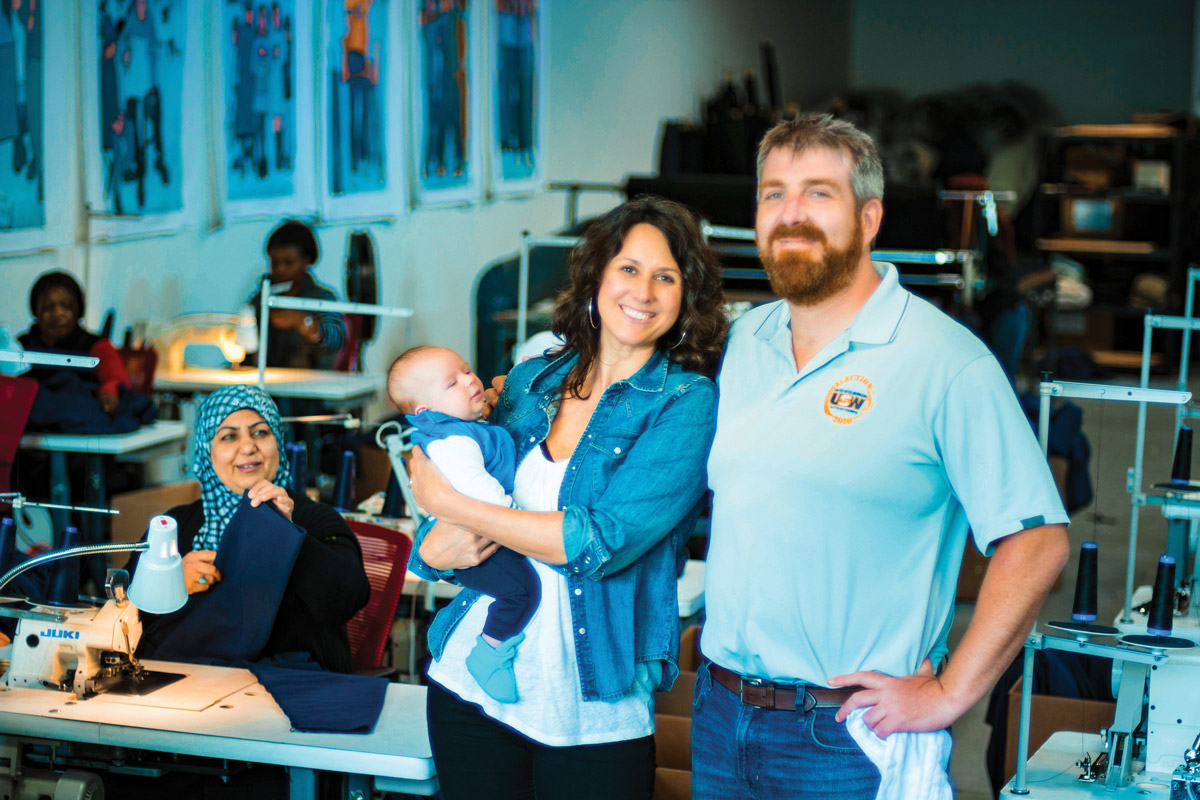
American Roots owners Whitney Reynolds and Ben Waxman have assembled a crew of 20 workers at their Westbrook clothing factory. Pictured with them are Anaam Jabbir, at far left, who is the union leader at the factory, and their son Arlo.
Inspiration and advice
Seeing her staff overcome such obstacles is a source of inspiration for Reynolds, she says, and she wants to share that inspiration with other women.
“My advice for a woman entering a field like this is, ‘Take the risk to be yourself,’” she says, quoting Bruce Springsteen in a Broadway performance she recently attended. “Be prepared to step out into your strengths. Leave your fear behind.”
That’s similar to counsel offered by Brodsky.
“Women often fear asking for help, often don’t want to speak up,” Brodsky says. “But my suggestion [for those entering manufacturing] is just do it. Even if you don’t know how, do it. Put your hand up, and ask for help if you need it, especially if you can find a mentor … Ultimately, what I need is people who know how to ask questions.”
Merrill, at Auburn Manufacturing, agrees: “Take the risk. Don’t be afraid to put yourself out there, even if you don’t know the answers. No one has to know everything.”
Leonard echoes her employee, but adds: “You need to apply what you know when you start in manufacturing, and you also have to be open about what you don’t know. If you don’t have a sense of curiosity, don’t bother. Opportunity is not going to come and find you.”
She also suggests that newcomers network actively and participate in industry associations. Good advice for most young employees, but especially important for female ones. “Getting involved is a way of gaining credibility in a field that doesn’t always give you that,” she says.
Leonard and others are optimistic that more women will go into industries like theirs.
“Look at me — I just enjoy making stuff,” says Brodsky, who had owned and operate a marketing company before launching Sterling. “There are lots of places for women in manufacturing here in Maine.”
Leonard finds it “natural” that women work in fabric making, even high-tech fabric making like the kind performed at AMI. Perhaps that has to do with New England’s roots in manufacturing. As far back as the early 1800s, at the start of the Industrial Revolution, girls and young women made up the majority of workers at textile mills in Lowell, Mass., and other nearby cities.
“Women have always been part of apparel-making,” says Reynolds. “Why shouldn’t we also be leading it?” ■
Want to know more?
Whether you’re ready for a new professional challenge in Maine’s manufacturing field, hoping to begin your career there, or just curious to learn more about an economic sector employing over 50,000 Mainers and providing 9% of the gross state product, here are some online resources you may want to check out.
Manufacturers Association of Maine: Good information about all things manufacturing, including industry networking events, career information and yearly analysis of Maine’s manufacturing environment. mainemfg.com
Women in Manufacturing: A national business networking organization for female manufacturing professionals, with chapters in Massachusetts and Connecticut. womeninmanufacturing.org
The Manufacturing Institute: This arm of the National Association of Manufacturers advocates for workforce development and coordinates the STEP Ahead Awards program, which recognizes the national achievements of women in manufacturing. themanufacturinginstitute.org
Women’s Business Center: The Women’s Business Center offers advising, workshops and events for women in manufacturing and all types of business. The center is part of Coastal Enterprises Inc., a nonprofit business financing organization based in Brunswick and serving rural Maine. ceimaine.org
The Institute for Women’s Policy Research: A think tank conducting public policy research and analysis to improve the lives of women throughout the country. The institute maintains a bank of rich, state-specific data about gender, employment and economic opportunity. iwpr.org


